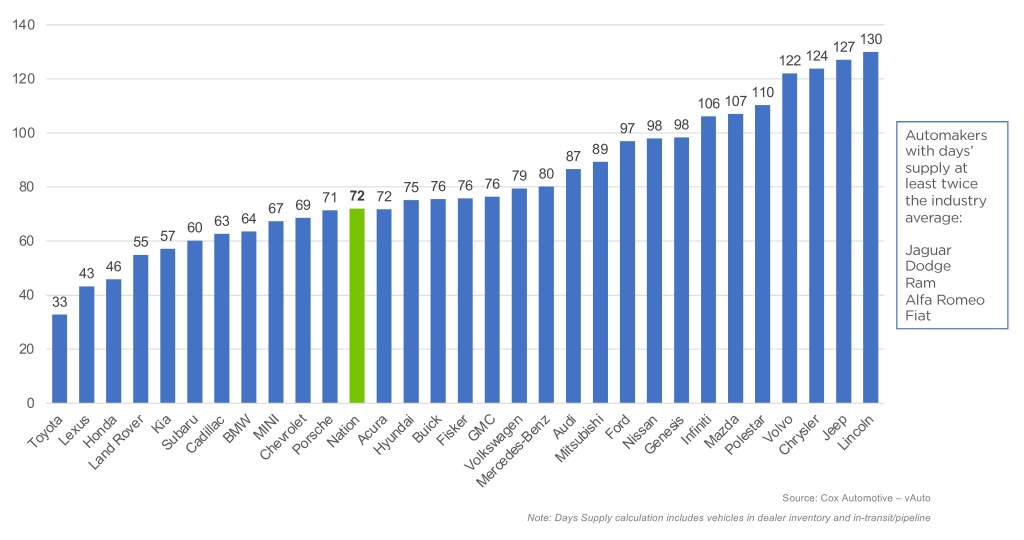Data Point
New-Vehicle Inventory Increases While Steady Sales Pull Down Days’ Supply
Thursday April 18, 2024
Article Highlights
- Days’ supply drops to 72 days as sales increase through the month of March.
- Toyota dominates the top sellers, even with the tightest inventory levels.
- Among the top 20 markets, colder weather cities continue to hold the highest days’ supply.
April opened with 72 days of new-vehicle supply across the industry, down seven days from the start of March, as higher volumes in recent weeks helped to keep inventory in check. According to Cox Automotive’s analysis of vAuto Live Market View, the total U.S. supply of available unsold new vehicles opened April at 2.77 million units. That is 870,000 units – or 46% – above a year ago but only marginally higher than the start of March when the revised inventory volume stood at 2.74 million.
2.77M
Total Inventory
as of April 1, 2024
72
Days’ Supply
$47,240
Average Listing Price
Days’ supply at the start of March hit 79, down slightly from February, but fell through the month as sales generally picked up. New-vehicle days’ supply decreased by 9% over the most recent weeks to 72 days, which is 17 days (30%) higher than the same time last year.
The Cox Automotive days’ supply is based on the daily retail sales rate for the most recent 30-day period. Sales during that period ran 11% ahead of a year ago and were also higher month over month. For the full month of March, the seasonally adjusted annual rate (SAAR) was 15.5 million, putting 2024 on track to be the best new-vehicle sales year since 2019.
Most Asian-Based Brands Have Tight Supplies
The Live Market View data continues to show many Asian-based brands – Nissan and Infiniti, the exceptions – with the tightest days’ supply. Toyota continues to thrive on less than half the industry average, with 33 days’ supply. Lexus and Honda are only slightly more well stocked with 43 and 46 days’ supply, respectively, vastly different from some of their domestic competitors. Ford kicked off April with days’ supply at 97, Lincoln at 130, and Jeep at 127. Dodge and Ram both had days’ supply of more than twice the industry average. Of the domestic makes, Chevrolet and Cadillac both began the month with days’ supply below the industry average.
MARCH DAYS’ SUPPLY OF INVENTORY BY BRAND
Fiat has the highest inventory level, while Rivian has the lowest inventory this month.

The average listing price for a new-vehicle at the start of April was $47,240, higher versus one year ago by only $177, or less than 1%. Vehicles under $40,000 continue to have the tightest supply. At a price point over $80,000, the market hits the industry average at 75 days’ supply, and midrange-priced vehicles are all above the industry average as measured by days’ supply.
Erin Keating
Erin Keating is an Executive Analyst and Senior Director of Economic and Industry Insights at Cox Automotive. She has 25 years of experience in marketing and communications, including 10 years with Audi of America, where she also ran Audi Motorsport North America. With a focus on the wider industry, the individual automakers, and consumer shopping and buying behavior for new vehicles, Erin provides analysis and insights leveraging the breadth and depth of data from DRiVEQ, Cox Automotive’s data intelligence engine. Upon joining Cox Automotive, Erin was responsible for Enterprise Data Strategy – Partnerships. Erin is based in Atlanta.

